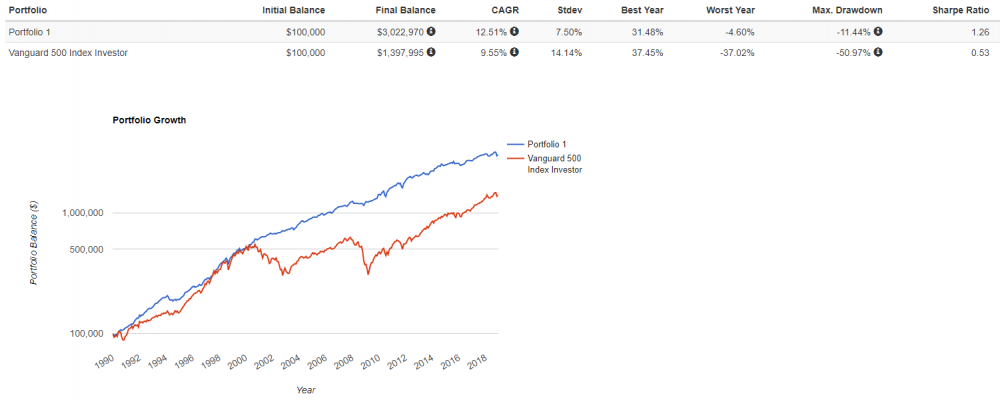
In February of 2017, I wrote an article about combining together the concepts of momentum and put selling. You can find that article here as prerequisite reading. With this post, we'll look at how the strategy presented has done since then, along with some additional implementation ideas.
Selling puts on the S&P 500 has been a good strategy since the mid 1980's, based on CBOE's Put Write Index (PUT). In the referenced article, I showed how adding a time series momentum filter to PUT further improved risk-adjusted results, while also mentioning that creative investors could use assets other than T-bills/money market as the underlying source of collateral. We'll also look at that here.
First: Replicating the strategy in the article, how has it done out of sample the last 23 months?
Equal Weight Portfolio = PUT
Timing Portfolio = Times series momentum applied to PUT
Vanguard 500 Index Investor = VFINX

Given that the S&P 500 has been up so strongly during the last 23 months, it's no surprise that PUT underperformed the index. This is expected during strong bull markets where put selling has gains limited to the amount of monthly premium collected. The time series momentum overlay stayed invested the entire time, thereby doing its job since there were no major drawdowns along the way to avoid.
Next, we can look at two examples of ways to enhance the returns of our momentum approach. First, instead of holding bonds only when momentum is negative, we'll hold bonds (instead of T-bills) all the time (via VBMFX) in addition to our put selling. This further improves results, but it should be noted that this could only be done in a non-retirement margin account. All the brokers I'm aware of would prohibit this type of portfolio in an IRA.

The risk-adjusted results here are impressive for such a simple strategy. So what are the drawbacks? Here are a few to consider:
1. We saw in the last 23 months that put selling can underperform in a raging bull market. Investors could consider substituting part of their traditional equity exposure with put selling for this reason.
2. Future returns may be lower. As more market participants become aware of the strong historical risk-adjusted returns offered to those willing to sell options, more supply can impact premiums.
3. Risk-adjusted bond returns have been extraordinary since 1990 due to falling rates, with VBMFX producing a Sharpe Ratio of 0.78. This is unlikely going forward.
4. Time-series momentum can and will occasionally create whipsaw trades. Again, the solution to this is continuing to maintain a healthy portion of your equity portfolio with traditional index funds and/or ETF's.
5. The returns shown are pre-tax, and option selling is tax inefficient due to the high turnover, even after considering the special 60/40 treatment that cash settled index options receive. All of the bond income would be taxable as well (although substituting VBMFX with VWITX gives similar results). The ability to defer capital gains until sold and forever when bequeathed is one of many reasons why index funds are so attractive.
One more example: Instead of collateralizing 100% of our put selling with bonds, we'll do it with 20% equities and 80% bonds. Since PUT is based on large caps, we'll add factor diversification by allocating half of the equities to a US small cap value index, and the other half to an International small cap value and emerging market value index.

Adding cash equities to the portfolio further improves results, and would also improve tax efficiency. Even though this type of portfolio may be simple, its creativity makes it quite unconventional. But for someone willing to succeed unconventionally, the data suggests the minimal effort involved is worth it. And for those lacking the time, interest, or confidence to do it themselves, we run portfolios similar to this for clients if you'd like to have a discussion about it with us. Thanks for reading.
Jesse Blom is a licensed investment advisor and Vice President of Lorintine Capital, LP . He provides investment advice to clients all over the United States and around the world. Jesse has been in financial services since 2008 and is a CERTIFIED FINANCIAL PLANNER™ . Working with a CFP® professional represents the highest standard of financial planning advice. Jesse has a Bachelor of Science in Finance from Oral Roberts University. Jesse is managing the LC Diversified portfolio and forum, the LC Diversified Fund, as well as contributes to the Steady Condors newsletter.
What Is SteadyOptions?
Full Trading Plan
Complete Portfolio Approach
Diversified Options Strategies
Exclusive Community Forum
Steady And Consistent Gains
High Quality Education
Risk Management, Portfolio Size
Performance based on real fills
Non-directional Options Strategies
10-15 trade Ideas Per Month
Targets 5-7% Monthly Net Return
Recent Articles
Articles
Pricing Models and Volatility Problems
Most traders are aware of the volatility-related problem with the best-known option pricing model, Black-Scholes. The assumption under this model is that volatility remains constant over the entire remaining life of the option.
By Michael C. Thomsett, August 16

- Added byMichael C. Thomsett
- August 16
Option Arbitrage Risks
Options traders dealing in arbitrage might not appreciate the forms of risk they face. The typical arbitrage position is found in synthetic long or short stock. In these positions, the combined options act exactly like the underlying. This creates the arbitrage.
By Michael C. Thomsett, August 7

- Added byMichael C. Thomsett
- August 7
Why Haven't You Started Investing Yet?
You are probably aware that investment opportunities are great for building wealth. Whether you opt for stocks and shares, precious metals, forex trading, or something else besides, you could afford yourself financial freedom. But if you haven't dipped your toes into the world of investing yet, we have to ask ourselves why.
By Kim, August 7

- Added byKim
- August 7
Historical Drawdowns for Global Equity Portfolios
Globally diversified equity portfolios typically hold thousands of stocks across dozens of countries. This degree of diversification minimizes the risk of a single company, country, or sector. Because of this diversification, investors should be cautious about confusing temporary declines with permanent loss of capital like with single stocks.
By Jesse, August 6

- Added byJesse
- August 6
Types of Volatility
Are most options traders aware of five different types of volatility? Probably not. Most only deal with two types, historical and implied. All five types (historical, implied, future, forecast and seasonal), deserve some explanation and study.
By Michael C. Thomsett, August 1

- Added byMichael C. Thomsett
- August 1
The Performance Gap Between Large Growth and Small Value Stocks
Academic research suggests there are differences in expected returns among stocks over the long-term. Small companies with low fundamental valuations (Small Cap Value) have higher expected returns than big companies with high valuations (Large Cap Growth).
By Jesse, July 21

- Added byJesse
- July 21
How New Traders Can Use Trade Psychology To Succeed
People have been trying to figure out just what makes humans tick for hundreds of years. In some respects, we’ve come a long way, in others, we’ve barely scratched the surface. Like it or not, many industries take advantage of this knowledge to influence our behaviour and buying patterns.

- Added byKim
- July 21
A Reliable Reversal Signal
Options traders struggle constantly with the quest for reliable
By Michael C. Thomsett, July 20

- Added byMichael C. Thomsett
- July 20
Premium at Risk
Should options traders consider “premium at risk” when entering strategies? Most traders focus on calculated maximum profit or loss and breakeven price levels. But inefficiencies in option behavior, especially when close to expiration, make these basic calculations limited in value, and at times misleading.
By Michael C. Thomsett, July 13

- Added byMichael C. Thomsett
- July 13
Diversified Leveraged Anchor Performance
In our continued efforts to improve the Anchor strategy, in April of this year we began tracking a Diversified Leveraged Anchor strategy, under the theory that, over time, a diversified portfolio performs better than an undiversified portfolio in numerous metrics. Not only does overall performance tend to increase, but volatility and drawdowns tend to decrease: